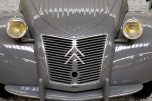Cars after 1950 - Modern Times
Panhard & Levassor Dyna Z1
1956
Code 6010
Body style: saloon
Panhard had already taken the world of small cars by storm with the launch and sale of its small Dyna saloons that were presented at the 1946 Paris Motor Show. In 1953, the firm did it again with another original saloon. “Are you looking for a car that can achieve speeds of 130 kph, with six seats and a consumption of 7 litres per 100 km? There is only one, the Panhard Dyna Traction Avant.” This was the claim made for the car in a brochure for the 1953 Motor Show.
The first surprise is the car’s look, because significant amounts of work had been put into the aerodynamic design, leading to an unusual body shape. However, the earliest buyers were quick to appreciate its other qualities – space, comfort, safety, speed and most of all, fuel economy. Even with an intensive usage, the consumption was only 7 litres per 100 km (34 mpg). In expert hands, it ran away with the prize every time it took part in Economy Run events.
The first-generation Dynas, with the sober designs of Jean-Albert Grégoire (front-wheel drive, two-cylinder flat air-cooled engine, extensive use of aluminium) were felt to be a little claustrophobic, but the second-generation Z1s aimed for a spacious interior, with a strong focus on aerodynamics. The overall shape of this Panhard Z1 is very clean, and follows Grégoire’s initial stripped-down principles in a new form. It all came about through a research effort, described in the Cité de l’Automobile exhibition, that included the eye-catching Dynavia, with its droplet form.
The underbody is a smooth, flat platform, with a tubular bar across it near the front, like a barrier behind which there are no mechanical components. The two-cylinder, air-cooled engine block and four-speed gearbox is right at the front of the vehicle, and the car has four independent wheels with a large range of steering freedom. This large Dyna has the “120” engine, an extremely efficient 851 cc affair that produced 42 horsepower. The aluminium passenger compartment literally sits right on top of the underbody with its engine assembly. To the rear there is a large boot, and to the front, a single-unit assembly comprising bonnet, wings and grille.
This model, Code 6010, is from the second series, still boasting the aluminium body, but no longer with the large bumper ends (1955).
When the Panhard automobile division was bought out by Citroën, the aluminium body was replaced by a steel sheet assembly for cost-cutting reasons. The car remained popular, even though today’s “fans” in Panhard clubs generally prefer the original models with their aluminium body.





















